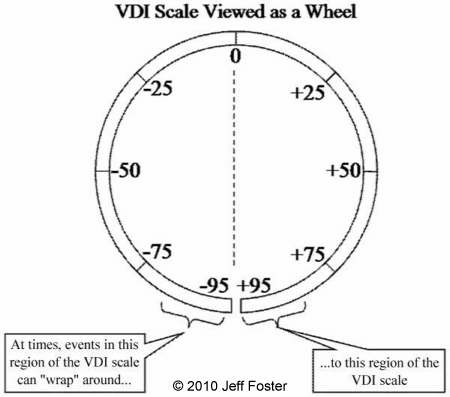Jeff Foster
New member
The V3's Analysis Screen is a great feature of the V3. It allows the user to see more of the details of what the detector's computer sees. Because of this, the user can better understand the target being detected, before it is dug, and the user can see firsthand situations where the single frequency modes may be best for certain types of targets. However, some basics of detector operation need to be reviewed to better understand how these Analysis Screens should be interpreted.
Fundamental to the V3 (and DFX, MXT, etc.) operation is the VDI scale. While this is sometimes shown as a straight line, with -95 at one end and +95 at the other, it is really a wheel, or circle, with -95 and +95 back-to-back, like so:

Because the VDI scale is like a wheel, certain effects that occur near the -95/+95 boundary tend to spill across the boundary. Of huge importance to V3 users (and DFX users for that matter) is the influence of the ground-balance, which has effects that wrap across the -95/+95 portion of the wheel.
This notion, that effects of the ground-balance may spill across the part of the VDI wheel, where -95 and +95 are back-to-back, may sound a little scary to understand, but it's not really. And the effects can be clearly seen on the V3's Analysis Screen and in day to day V3 operation.
First, let me provide a little foreshadowing of what I'll explain. One thing that you'll see is why it is often said that 2.5kHz is best for "silver" (that is to say U.S. style silver coins with high-VDI numbers, not antiquated "hammered" silver coins found in Europe with much lower VDI numbers). The fact is that 22.5kHz and 2.5kHz have roughly the same sensitivity for silver (i.e. high-VDI targets)
Fundamental to the V3 (and DFX, MXT, etc.) operation is the VDI scale. While this is sometimes shown as a straight line, with -95 at one end and +95 at the other, it is really a wheel, or circle, with -95 and +95 back-to-back, like so:

Because the VDI scale is like a wheel, certain effects that occur near the -95/+95 boundary tend to spill across the boundary. Of huge importance to V3 users (and DFX users for that matter) is the influence of the ground-balance, which has effects that wrap across the -95/+95 portion of the wheel.
This notion, that effects of the ground-balance may spill across the part of the VDI wheel, where -95 and +95 are back-to-back, may sound a little scary to understand, but it's not really. And the effects can be clearly seen on the V3's Analysis Screen and in day to day V3 operation.
First, let me provide a little foreshadowing of what I'll explain. One thing that you'll see is why it is often said that 2.5kHz is best for "silver" (that is to say U.S. style silver coins with high-VDI numbers, not antiquated "hammered" silver coins found in Europe with much lower VDI numbers). The fact is that 22.5kHz and 2.5kHz have roughly the same sensitivity for silver (i.e. high-VDI targets)



